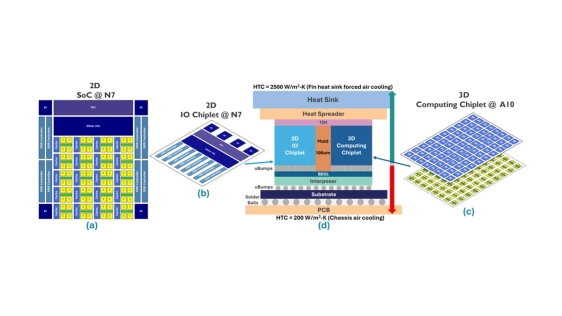Thermal Implications of Non-Uniform Power in BSPDN-Enabled 2.5D/3D Chiplet-based Systems-in-Package using Nanosheet Technology
By Yukai Chen 1, Massimiliano Di Todaro 1,3, Bjorn Vermeersch 1, Herman Oprins 1, Daniele Jahier Pagliari 3, Julien Ryckaert 1, Dwaipayan Biswas 1 and James Myers 2
1 IMEC, Belgium
2 IMEC, United Kingdom
3 DAUIN, Politecnico di Torino, Italy

Abstract
 Advances in nanosheet technologies have significantly increased power densities, exacerbating thermal management challenges in 2.5D/3D chiplet-based Systems-in-Package (SiP). While traditional thermal analyses often employ uniform power maps to simplify computational complexity, this practice neglects localized heating effects, leading to inaccuracies in thermal estimations, especially when comparing power delivery networks (PDN) in 3D integration. This work examines the thermal impact of non-uniform power distributions on SiPs utilizing frontside (FSPDN) and backside (BSPDN) power delivery approaches. Using high-resolution thermal simulations with non-uniform power maps at resolutions down to 5 micrometers, we demonstrate that uniform power assumptions substantially underestimate peak temperatures and fail to reveal critical thermal differences between BSPDN and FSPDN configurations in 3D scenarios. Our results highlight that BSPDN configurations in 3D, although beneficial in simplified uniform scenarios, exhibit pronounced thermal penalties under realistic, localized workloads due to limited lateral heat spreading. These findings emphasize the necessity of adopting fine-grained, workload-aware power maps in early-stage thermal modeling to enable accurate PDN assessment and informed thermal-aware design decisions in advanced nanosheet-based 3D SiP.
Advances in nanosheet technologies have significantly increased power densities, exacerbating thermal management challenges in 2.5D/3D chiplet-based Systems-in-Package (SiP). While traditional thermal analyses often employ uniform power maps to simplify computational complexity, this practice neglects localized heating effects, leading to inaccuracies in thermal estimations, especially when comparing power delivery networks (PDN) in 3D integration. This work examines the thermal impact of non-uniform power distributions on SiPs utilizing frontside (FSPDN) and backside (BSPDN) power delivery approaches. Using high-resolution thermal simulations with non-uniform power maps at resolutions down to 5 micrometers, we demonstrate that uniform power assumptions substantially underestimate peak temperatures and fail to reveal critical thermal differences between BSPDN and FSPDN configurations in 3D scenarios. Our results highlight that BSPDN configurations in 3D, although beneficial in simplified uniform scenarios, exhibit pronounced thermal penalties under realistic, localized workloads due to limited lateral heat spreading. These findings emphasize the necessity of adopting fine-grained, workload-aware power maps in early-stage thermal modeling to enable accurate PDN assessment and informed thermal-aware design decisions in advanced nanosheet-based 3D SiP.
To read the full article, click here
Related Chiplet
- Interconnect Chiplet
- 12nm EURYTION RFK1 - UCIe SP based Ka-Ku Band Chiplet Transceiver
- Bridglets
- Automotive AI Accelerator
- Direct Chiplet Interface
Related Technical Papers
- Workflows for tackling heterogeneous integration of chiplets for 2.5D/3D semiconductor packaging
- Five Workflows for Tackling Heterogeneous Integration of Chiplets for 2.5D/3D
- Cambricon-LLM: A Chiplet-Based Hybrid Architecture for On-Device Inference of 70B LLM
- Co-Optimization of Power Delivery Network Design for 3-D Heterogeneous Integration of RRAM-Based Compute In-Memory Accelerators
Latest Technical Papers
- LaMoSys3.5D: Enabling 3.5D-IC-Based Large Language Model Inference Serving Systems via Hardware/Software Co-Design
- 3D-ICE 4.0: Accurate and efficient thermal modeling for 2.5D/3D heterogeneous chiplet systems
- Compass: Mapping Space Exploration for Multi-Chiplet Accelerators Targeting LLM Inference Serving Workloads
- Chiplet technology for large-scale trapped-ion quantum processors
- REX: A Remote Execution Model for Continuos Scalability in Multi-Chiplet-Module GPUs